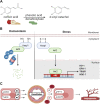Lactobacillus plantarum probiotic induces Nrf2-mediated antioxidant signaling and eNOS expression resulting in improvement of myocardial diastolic function
- PMID: 34506225
- PMCID: PMC8616611
- DOI: 10.1152/ajpheart.00278.2021
Lactobacillus plantarum probiotic induces Nrf2-mediated antioxidant signaling and eNOS expression resulting in improvement of myocardial diastolic function
Abstract
Yorkshire swine were fed standard diet (n = 7) or standard diet containing applesauce rich in caffeic acid with Lactobacillus plantarum (n = 7) for 3 wk. An ameroid constrictor was next placed around the left coronary circumflex artery, and the dietary regimens were continued. At 14 wk, cardiac function, myocardial perfusion, vascular density, and molecular signaling in ischemic myocardium were evaluated. The L. plantarum-applesauce augmented NF-E2-related factor 2 (Nrf2) in the ischemic myocardium and induced Nrf2-regulated antioxidant enzymes heme oxygenase-1 (HO-1), NADPH dehydrogenase quinone 1 (NQO-1), and thioredoxin reductase (TRXR-1). Improved left ventricular diastolic function and decreased myocardial collagen expression were seen in animals receiving the L. plantarum-applesauce supplements. The expression of endothelial nitric oxide synthase (eNOS) was increased in ischemic myocardial tissue of the treatment group, whereas levels of asymmetric dimethyl arginine (ADMA), hypoxia inducible factor 1α (HIF-1α), and phosphorylated MAPK (pMAPK) were decreased. Collateral-dependent myocardial perfusion was unaffected, whereas arteriolar and capillary densities were reduced as determined by α-smooth muscle cell actin and CD31 immunofluorescence in ischemic myocardial tissue. Dietary supplementation with L. plantarum-applesauce is a safe and effective method of enhancing Nrf2-mediated antioxidant signaling cascade in ischemic myocardium. Although this experimental diet was associated with a reduction in hypoxic stimuli, decreased vascular density, and without any change in collateral-dependent perfusion, the net effect of an increase in antioxidant activity and eNOS expression resulted in improvement in diastolic function.NEW & NOTEWORTHY Colonization of the gut microbiome with certain strains of L. Plantarum has been shown to convert caffeic acid readily available in applesauce to 4-vinyl-catechol, a potent activator of the Nrf2 antioxidant defense pathway. In this exciting study, we show that simple dietary supplementation with L. Plantarum-applesauce-mediated Nrf2 activation supports vascular function, ameliorates myocardial ischemic diastolic dysfunction, and upregulates expression of eNOS.
Keywords: antioxidant; chronic myocardial ischemia; diastolic function; endothelial function; probiotic.
Conflict of interest statement
No conflicts of interest, financial or otherwise, are declared by the authors.
Figures






References
Publication types
MeSH terms
Substances
Associated data
Grants and funding
LinkOut - more resources
Full Text Sources
Miscellaneous

